Reports
Pakistan’s Growing Uranium Enrichment Program
by David Albright, Sarah Burkhard, and Frank Pabian
May 30, 2018
Pakistan has invested heavily in recent years in renovating and expanding its nuclear infrastructure, including the parts related to making nuclear explosive materials. The Institute for Science and International Security monitors Pakistan’s nuclear activities and in this report examines Pakistan’s efforts to expand its capability to enrich uranium for nuclear power reactors and for use in nuclear weapons. The report outlines, using government budget documents, Pakistan’s progress in building a large-scale enrichment plant with the stated aim of making low enriched uranium for nuclear power reactors and, using commercial satellite imagery, surveys a construction site at the A.Q. Khan Research Laboratories near Kahuta (called the Kahuta site in the report) that is likely a relatively large gas centrifuge plant under construction and could produce enriched uranium for civil or military purposes. This report discusses the purpose and size of the likely enrichment plant at Kahuta and estimates the amount of enriched uranium it could produce. We could not determine if Pakistan is building one or two enrichment plants. We are certainly interested in learning more.
While much of the world’s attention has been directed to the nuclear programs of Iran and North Korea, Pakistan has greatly expanded its nuclear complex dedicated to producing nuclear weapons. One European official stated in an interview in late 2016 that in terms of instances of illicit nuclear-related procurements by the three countries, Pakistan has carried out the most. Over the last decade, Pakistan has renovated or expanded its uranium enrichment, plutonium production, and nuclear weaponization capabilities, according to this official. It has also been expanding its number of nuclear power plants and the means to make fuel for these new reactors.
One poorly understood part of this renovation is a new construction site at the Khan Research Laboratories near Islamabad that is nearing completion and is suspected to be a fairly large, secret gas centrifuge enrichment plant. Pakistan has not responded to media reports that it could be a centrifuge plant. If it is, one question is: is it intended to be a military site aimed at adding to Pakistan’s nuclear weapons arsenal and a hoped-for nuclear-powered submarine program? Or would it be used to make low enriched uranium (LEU) for nuclear power reactors? Will it serve both purposes? With on-going concern about possible nuclear cooperation between Pakistan and Saudi Arabia, could this site somehow involve the Saudi kingdom? With so many questions, Pakistan should be pressed to provide more clarity about its enrichment plans.
Unlike India, Pakistan has barely separated its civil and military nuclear facilities and in general remains highly secretive about its nuclear program. The opaqueness of Pakistan’s nuclear program, its expanding nuclear weapons arsenal, and its refusal to separate its military and civilian nuclear program are cited as reasons by many countries opposing Pakistan’s membership into the Nuclear Suppliers Group (NSG), as well as any country supplying it with additional nuclear power reactors or other fuel cycle facilities or capabilities. Such supply is viewed by many countries as a violation of NSG guidelines. Although China successfully grandfathered under these guidelines the provision of two nuclear power reactors, other NSG members have objected to China continuing to supply additional nuclear power reactors that are clearly not grandfathered. Moreover, Pakistan’s opaqueness is a sufficient reason to try to thwart its illicit purchases from abroad for its nuclear programs, particularly nuclear weapons-related programs.
New Centrifuge Plant?
The Institute first started receiving notice from government sources in the summer of 2015 that Pakistan was receiving specialized equipment for an extension of its centrifuge program at Kahuta and that a new building was being constructed there.
In 2016, IHS Janes in collaboration with Project Alpha at King’s College published a satellite imagery study, backed up by centrifuge-related procurement data, about this site at Kahuta.1 Although the report listed the site as a probable centrifuge plant, it also listed anomalies that pointed away from this conclusion and said little about the site’s intended purpose or ultimate enrichment capacity. 2 In combination with the Institute’s information, public information supports that more than one government has identified this site as related to gas centrifuge enrichment.
There are sufficient reasons to believe this assessment and investigate the site’s potential capacity for both civil and military enrichment purposes. However, determining its exact purpose remains difficult without more information from Pakistan or perhaps intelligence communities.
A confounding factor is that Pakistan has stated that it is building a relatively large uranium enrichment plant at another location in Mianwali, Western Punjab. The purpose of this facility is reportedly to make low enriched uranium for nuclear power plants. Our inability to physically locate this facility complicates the assessment of the new facility at Kahuta. If all the evidence is taken at face value, it would imply that Pakistan is building two large centrifuge enrichment plants.
Publicly Announced Uranium Enrichment Plant
There is justification for assessments that the new site at Kahuta would be part of a civil enrichment effort, although the evidence is ambiguous, and Pakistan has not said so or equivalently committed that such a site would be only for peaceful, non-military purposes. Nonetheless, this evidence is based in part on Pakistani governmental budget documents that show planning and expenditures for construction by the Pakistan Atomic Energy Commission (PAEC) of a fuel enrichment plant that is slated for operation in June 2022 (originally slated for a June 2018 opening). It appears to be part of a larger civil effort to make fuel for nuclear power reactors.3 Is this plant the one at Kahuta? The evidence is unclear.
Pakistani media reports, based on Pakistani government sources, and Pakistani budget documents state that Pakistan is implementing a plan to build a uranium enrichment plant as part of an effort to make nuclear power reactor fuel domestically, e.g. make low enriched uranium and turn it into fuel for light water reactors that generate electricity.4 According to this information, the enrichment plant, called the National Fuel Enrichment Plant (NFEP), is to be part of the Nuclear Power Fuel Complex (NPFC) that also includes a Chemical Processing Plant (CPP), a Seamless Tube Plant-1 (STP-1), a Fuel Fabrication Plant (FFP), and a Nuclear Power Fuel Testing Project (NPF-TP). The News reported that Pakistan would seek from China the fuel technology for its future nuclear power plants.5 However, missing in this media report is any discussion of whether Beijing has provided or will provide centrifuge or centrifuge-related goods to an enrichment plant.
The NFEP is slated to cost 14,248 million rupees, or about $128 million at today’s exchange rates.6 Of this total, about 5,571 million rupees will be the foreign exchange component.7 The foreign exchange component may be for buying goods and technology from abroad in foreign currencies and may be separate from funds spent domestically in rupees. Subtracting this component from the total expected costs, the domestic costs of construction would be 8,677 million rupees, or about $78 million. The large fraction of the foreign component raises questions of how it will obtain the needed goods and services for this nuclear facility, given the limitations imposed by the NSG. Will China violate the NSG guidelines to outfit this facility and the others in the Nuclear Power Fuel Complex? Will Pakistan conduct extensive illegal procurements from abroad to outfit these facilities?
Construction Progress of the NFEP
Pakistani government budget documents provide only a partial snapshot of construction progress at the NFEP. No monies had been allocated up to June 30, 2013, but by June 30, 2015, about 800 million rupees had been spent. Through June 30, 2017, the last year for which data are available, total expenditures for the NFEP amounted to 1,515 million rupees, or about $15 million at the June 2017 exchange rate. This amounts to about 11 percent of the total budgeted cost for the enrichment plant as of June 30, 2017.
There is little information in Pakistan’s budget documents about tangible construction progress on the ground at the NFEP. The budget documents do not describe the status of the construction, but only future milestones. As of June 3, 2016, the key milestone listed for the upcoming fiscal year 2016-17 (July 1, 2016 to June 30, 2017) was to establish a “boundary wall/site office construction, infrastructure design and development, grid station installation and procurement of critical machinery/equipment.”8 The same language appears in the next year’s budget estimate (for 2017-18), despite the expenditure of several million dollars in 2016-17.9 It should be noted that several of the major facilities in the Nuclear Power Fuel Complex, including the FFP, NFEP, CPP, and STP-1 have this same description for the 2016-17 milestone. This could imply they share a common site, based on review of official budget documents.10
Moreover, the repetition of the milestones across two fiscal years could reflect slowdowns in construction caused by the significant cuts made by the government in the PAEC’s budget in 2017.11 In any case, the NFEP does not appear to have progressed substantially. Moreover, given the extensive outside assistance Pakistan will need to build the NPFC, a portion of which will likely entail illicit procurements from abroad or foreign supply in violation of the NSG guidelines, Pakistan may proceed slowly on this project.
Location
The budget documents state that the National Fuel Enrichment Plant and the Chemical Processing Plant will be in Mianwali, which is either a city or a district in the northwestern part of Punjab province (the documents do not make it clear which will be the site). No information could be found about the specific location of the National Fuel Enrichment Plant or associated fuel fabrication facilities, or whether the site under construction at Kahuta is this enrichment plant. Kahuta is not in the Mianwali district, but it is possible that Pakistan intentionally lists a false district or city in the budget documents. Moreover, the planned facilities may or may not be co-located; the Nuclear Power Fuel Testing Project (NPF-TP) is listed in budget documents in another district, namely Faisalabad.12
A broad search for the Nuclear Power Fuel Complex under construction in Mianwali was unsuccessful. One obvious candidate is the Chashma site. The Chashma nuclear power reactors, the Kundian Fuel Fabrication Plant, and a suspected plutonium reprocessing facility are all located in a large complex that is in the Mianwali district.13 Figure 1 gives an overview of the Chashma site as of January 20, 2018 but does not reveal any obvious construction that may be associated with the government-announced Nuclear Power Fuel Complex. However, there is some new construction that may include parts of this complex.
The Chashma site has a great deal of empty land on which to add NPFC facilities. However, as discussed above, according to the federal budget documents, about 10 percent of the budget has already been spent. With that amount of money spent, the project would likely be visible in satellite imagery; for example, a new inner security boundary should be visible.
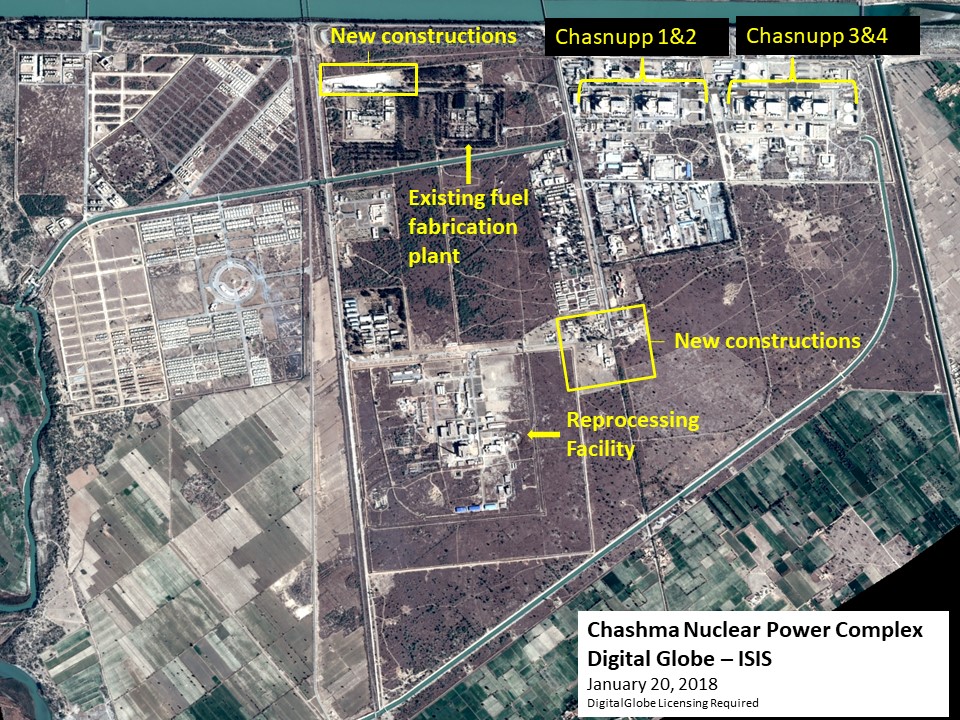
Figure 1. Chashma site with a variety of nuclear facilities, including new construction.
A preliminary search of the surrounding area and near the city of Mianwali did not reveal any major new construction projects. Given the vagueness of the budget documents, it is possible that Pakistan is deliberately hiding the enrichment plant’s true location. However, there appears to be little justification for hiding the location of the other constituents of the Nuclear Power Fuel Complex.
Enrichment Output of the Publicly Announced Enrichment Plant
Information about the expected size of the NFEP can be derived from media reports. In 2007, Pakistan announced that it plans to have enough nuclear power plants to generate 8,800 megawatts-electrical by 2030.14 Of this total, Pakistan announced in 2007 that it intended to produce ultimately about one-third of the enriched uranium fuel for these reactors, requiring an estimated enrichment output of approximately 300,000 separative work units per year (SWU/yr).15 This estimate is confirmed in a 2007 media report (based on interviews with Pakistani government officials), that stated that the project will involve three phases, each to be completed in five to six years and each to have a capacity of 100,000 SWU/yr, for a total of 300,000 SWU/yr when all three phases are completed.16 The report does not state whether all of these phases would be carried out in the same building or at the same site.
Implications
It is possible that the Kahuta site will house the NFEP but there are problems in arriving at this conclusion. Commercial satellite imagery (see below) shows what appears to be more construction work at the Kahuta site than described in the budget documents for the NFEP. It also shows that there is no visible construction of the other fuel fabrication facilities.
Pakistan may want to build the NFEP at Kahuta to benefit from its extensive centrifuge development and manufacturing capabilities and expertise that are already there. Building a centrifuge plant at Kahuta would thus make sense. It could build the other fuel fabrication facilities elsewhere.
Moreover, the dates of the expenditures appear consistent with the new Kahuta site being the location of the NFEP project. Given that Pakistan does not specifically include in its publicly available budget documents the activities at the Kahuta site, or whether they concern missile or uranium enrichment facilities, it may not be willing to admit publicly that it is building the NFEP there.
But without locating the other facilities in the Nuclear Power Fuel Complex, such as the Chemical Processing Plant or the Fuel Fabrication Plant, any conclusion about the location of the NFEP is difficult to draw. If the locations of these plants could be identified, perhaps it would be discovered that the NFEP is co-located with them, suggesting that the Kahuta site is not an enrichment plant or that Pakistan is building two large centrifuge plants simultaneously.
Kahuta Site
With the above background, the purpose of the new plant at Kahuta may be civil. Alternatively, it may be a replacement for an aging centrifuge complex at Kahuta built largely in the 1980s and 1990s to produce weapon-grade uranium for nuclear weapons.17 Or, it may serve both military and civil purposes, where it would supplement the NFEP or be its first installment. For example, the plant may be dedicated to making low enriched uranium only, but a fraction of that LEU could also be sent as needed to another centrifuge facility for further enrichment to weapons-grade and subsequent use in nuclear weapons. Another possibility is that a high security portion of this Kahuta building could hold cascades to enrich the LEU up to weapons-grade.
Commercial Satellite Imagery Results of New Kahuta Site
Commercial satellite imagery shows that construction on the Kahuta site has progressed. Figure 2 is a recent Digital Globe image from January 28, 2018 that shows that the external structures are largely finished. The main building, which could hold centrifuge cascades, is about 285 meters by 65 meters, for a total area of about 18,525 square meters. For comparison, the largest building at Kahuta suspected to be related to gas centrifuge enrichment is 106 meters by 85 meters, having an area of approximately 9000 square meters (or roughly half that of the new building).
The new facility is located at an old cricket field within the outermost security wall of Kahuta in an area that had been reserved mostly for purposes related to the site’s security forces (see figures 3 and 4). There are several large guard dog kennels nearby and a small arms firing/training range. Moreover, in close proximity are recreation facilities reserved for Kahuta personnel, such as a major auditorium and a swimming pool that is now usually empty (see figure 4). The area is the only feasible location for a large facility within the Kahuta site.
Figures 4 through 8 trace the construction project from initial ground clearing in early 2015 to 2017. The figures show the construction of a main building with a flat roof structure and multiple bays. The multiple bays are mostly identical in terms of size and layout and are more consistent with an internal layout of centrifuge cascades than alternatives like missile production which would have at least one central high-bay structure somewhere to allow for the operation of a large overhead crane.
The construction appears to show a building with only one level and no basement, consistent with a gas centrifuge plant. The height of the building is estimated at about 10.0-10.5 meters based on using the length of relevant shadows and a sun elevation of 36.5 degrees at the time the January 28, 2018 image was taken. The building appears to be a quite tall, single-story structure. For comparison purposes, it is not unlike a “big-box” retail store single story building found in the United States. There is also one upper-level rectangular section on the extreme southwestern end of the main building. Such upper-level sections could be used as control rooms or observations areas. There appear to be some internal, lower-roofed sections inside the main building for offices, feed materials handling, or support infrastructure along the southeastern edge of the interior of the building.
A bay structure is not necessarily expected at a Kahuta centrifuge plant. A 2000 video made by Khan Research Laboratories and seized abroad during the investigations of the notorious A.Q. Khan network’s illicit activities shows thousands of centrifuges, likely P2 centrifuges, in one large hall that is significantly larger than bays seen in this new building.18 Large cascade halls are also typical of early generation URENCO plants.
Nonetheless, cascade halls of the size of these bays are feasible. In addition to holding centrifuges, some of the bays may hold ancillary equipment, such as feed and withdrawal equipment, although as will be seen below, the plant has plenty of space for this type of equipment.
Based on assessing the images, 14 identical bays, each 15 meters by 45 meters, could be identified. The plant has other bays or structures at its end and on one side, but these are assessed as less likely to hold centrifuges. They could hold ancillary equipment, workshops, and offices. Considering only the 14 bays, they have a total area of about 9450 square meters. The floor area under the roof of the building is about 18,525 square meters or double the area of these 14 bays.
Figure 2. The new construction site at Kahuta that is viewed as a probable gas centrifuge plant.
Figure 3. Overview of the Khan Research Laboratories showing major enrichment and missile facilities.
Figure 4. Early stage of construction of probable enrichment plant in January 2015.
Figure 5. Construction showing the emerging bay structure.
Figure 6. Probable centrifuge plant.
Figure 7. Probable centrifuge plant showing bay structure.
Figure 8. Probable centrifuge plant.
Click here for a time-lapse of the construction of the suspect gas centrifuge plant at the Kahuta site. Credit: Ian Stewart of Project Alpha via Planet Labs.
Comparison to North Korean Centrifuge Plant
The North Korean enrichment plant at Yongbyon has similar-sized halls as those in the suspect Kahuta plant. According to Dr. Siegfried Hecker, who visited the North Korean enrichment plant in 2010:
We walked up polished granite steps to the second-floor control room and observation area. The first look through the windows of the observation deck into the two long high-bay areas was stunning. Instead of seeing a few small cascades of centrifuges, which I believed to exist in North Korea, we saw a modern, clean centrifuge plant of more than a thousand centrifuges all neatly aligned and plumbed below us. There were two high-bay areas on each side of the central island. The high-bay areas were two stories high and we were told 50 meters long each. We estimated the width of the bays to be 12 to 15 meters. There were three lines of centrifuge pairs, closely spaced, the entire length of each hall.19
Commercial satellite imagery from 2010 shows a building with a blue roof about 120 meters long by 15 meters wide (see figure 9). Subtracting out the width of the central area leaves two halls each estimated to be about 50 meters by 15 meters, where each hall contains three cascades.
During a visit to Pyongyang, North Korea in late 2011, one of the authors of this report learned from North Korean nuclear officials at Yongbyon that each cascade comprised 344 P-2 centrifuges configured to make LEU, for a total of 2064 P-2 centrifuges in the plant. This information is significant since Pakistan developed cascades to make LEU using P-2 centrifuges that have this exact number of centrifuges, a coincidence that cannot be accidental. It is also known that Pakistan provided North Korea with sensitive information about enriching uranium in cascades of P-1 and P-2 centrifuges.20 Although A.Q. Khan admitted only to providing cascade technology to make LEU, suspicions remain that he or his colleagues also provided guidance on enriching uranium to weapon-grade.
In summary, the cascade halls in the North Korean facility are similar in size to the bays in the new building at Kahuta. In the North Korean case, each hall contains 1032 P-2 centrifuges. For later use, this value translates to an average “density” of centrifuges in each hall of about 1.38 centrifuges per square meter.
If the area of the entire building is considered instead, which is about 120 meters by 15 meters, the centrifuge density would be about 1.15 centrifuges per square meter. This value is about 83 percent of the density of centrifuges in each hall and reflects extra space needed for the control room, the feed and withdrawal equipment, power supplies, and offices. Absent information about the internal cascade hall(s), this value can serve as a rough density estimate for a similar, relatively small site dedicated to making LEU.
Figure 9. North Korean centrifuge plant (blue roof) at the Yongbyon fuel fabrication complex.
Other Khan-Related Cascade Hall Designs
The Pakistani centrifuge program designed many sizes of cascade halls. This observation is founded on the drawings of cascade halls seized in the early to mid-2000s by authorities investigating the A.Q. Khan network, which was at the time engaged in selling gas centrifuge plants to Libya that involved early generation P-1 and P-2 centrifuges. This transnational network was based in multiple countries, including Switzerland and South Africa, and authorities seized a wide range of data about Pakistani gas centrifuges and their cascades in these countries.
Information about such drawings available to the Institute covers the period up to about 2000. They do not provide any clear indication of Pakistan’s use of halls with the dimensions of 15 meters by 45 meters. Moreover, the drawings’ age may not reflect more recent advances in Pakistani cascade designs, reflecting the more advanced centrifuges that Pakistan is likely to build today (see below). However, information derived from the drawings offers insights into how Pakistan designs its cascade halls to make low enriched and weapon-grade uranium, and some of these data appears to have relevance to understanding the current construction at Kahuta.
Low Enriched Uranium Cascades. Many of the drawings concern the making of low enriched uranium of less than about 5 percent uranium-235. These halls are relatively consistent in their density of centrifuges, i.e. the number of centrifuges per square meter of floor space. However, they tend to be different in size than the bay structure in the new plant at Kahuta.
For example, an undated drawing shows a machine hall floor plan for 15 cascades capable of holding 172 centrifuges each, for a total of 2580 centrifuges. The hall’s overall dimensions are 81.44 meters by 28.93 meters. The dimensions of the floor plan include an equipment bay at one end and a row of offices down one side, but they do not include a corridor. This example is similar to considering an entire centrifuge facility to make LEU, and leads to a centrifuge density of about 1.1 centrifuge per square meter. However, there are some similarities to the North Korea cascade hall structure. Splitting the room lengthwise would result in two sections, each 81.44 meters by 14.5 meters, and each containing 1,290 centrifuges in 7.5 cascades of 172 centrifuges. Ignoring that one does not have partial cascades, the half section is similar in size, albeit it is longer, and it has a similar centrifuge density as the 2010 North Korean plant.
A drawing dated June 15, 1982 is for a cascade hall measuring 154.5 meters by 99 meters overall with 44 cascades each containing 344 centrifuges, for a total of 15,136 centrifuges. Surprisingly, the centrifuges in 80 percent of the cascades are identified as G-2 centrifuges, which are typically called P-2 centrifuges. This is a time period when Khan was first installing P-1 centrifuges at Kahuta and appears to reflect that Khan planned early-on to switch from P-1 to P-2 centrifuges. The centrifuge density in this hall is 0.99 centrifuges per meter.
An undated drawing with a floor plan for 16 cascades in two rows, where each cascade holds 168 centrifuges, for a total of 2,688. The dimensions of the cascades are 82.3 meters by 36.6 meters. The centrifuge density is 0.89 centrifuges per square meter.
Table 1 summarizes these results.
Table 1: Comparing Centrifuge Density in Khan-Style Centrifuge Plants Producing LEU
Weapon-Grade Uranium Production in Khan-Style Cascades
The new Kahuta building could also make weapon-grade uranium. To better understand Pakistan’s production of weapon-grade uranium, it is necessary to consider Pakistan’s four-step enrichment process of enriching from natural uranium to weapon-grade uranium.
A.Q. Khan and his colleagues succeeded in obtaining in the 1970s a design for cascades to produce low enriched uranium using URENCO technology from one of URENCO’s subcontractors.21 However, URENCO was not involved in making highly enriched uranium and Pakistan did not, as far as is known, acquire any pre-existing cascade designs for making weapon-grade uranium. To make weapon-grade uranium, Pakistan could have designed large cascades but these cascades would have been vulnerable to wide-scale breakage and inefficiencies. As a result, Pakistan, likely with foreign assistance, developed a novel way to make weapon-grade uranium in smaller cascades, in what are known as “step cascades.”
In this concept, which involves four steps, step 1 cascades are fed with natural uranium and enrich up to five percent enriched uranium. The product is fed to the step 2 cascades and onward enriched to about 20 percent enriched uranium. Step 3 takes this product and produces 60 percent enriched uranium, and step 4 takes the 60 percent material and produces weapon-grade uranium. Each step has its own feed and withdrawal equipment.
When enriching natural uranium to weapon-grade uranium, about 70 or 75 percent of the total separative output takes place in the step 1 cascades. Thus, Pakistan located step 1 cascades in separate rooms or even building (or buildings), such as the hall mentioned above in the 2000 video of P-2 centrifuges at Kahuta. The drawings mentioned above appear to all be step 1 cascades.
Steps 2, 3, and 4 represent the remaining 25 or 30 percent of the separative work needed to make weapon-grade uranium. Steps 3 and 4, as well as step 3 in some cases, were located in separate halls or building(s) for three additional reasons:
- Security control on the highly enriched uranium (uranium enriched over 20 percent),
- Criticality control on nuclear material, and
- Criticality control on equipment
Thus, in the four-step process, the step 1 cascades would be physically separated from the two steps dedicated to making highly enriched uranium and in some cases from steps 2-4 cascades. This design also means that finding a site making LEU up to five percent does not exclude that the LEU is for military purposes, perhaps enriched up to weapon-grade in a different hall or building.22
Libyan Centrifuge Plant
In a letter from A.Q. Khan to his colleagues in the Khan network in the late 1990s, Khan proposed that for Libya, they offer the following:
- For weapon-grade uranium concentrations, offer small size cascades suited to the smaller uranium hexafluoride mass flows in the Libyan plant.
- That 164 machines per cascade of either P-1 or P-2 machines be adopted for the LEU cascades (i.e. enriching from natural uranium to 20 percent enriched uranium in two steps).
- That smaller cascades be adopted for the two steps from 20 percent enriched uranium up to weapon grade uranium.
The facility would be able to make about 125 kilograms of weapon-grade uranium per year in these four steps operating in parallel.
Ginco Steel Drawings. As is well known, Libya never built this production-scale centrifuge plant; it ended this program under intense international pressure. However, Khan network investigators in countries where the network was based found a number of drawings for this proposed facility that included the location within the main building of the cascades in each of the four steps. The drawings were labelled as the Ginco Steel building. The basic layout and a number of variants had all been designed by a company in the United Arab Emirates (UAE), but when approached by authorities, company officials denied that they had ever seen what the buildings housed. In particular, they stated that they had not drawn the cascade layouts shown on the drawings.
The drawings show a complex consisting of:
- A large central building
- Three supporting buildings for power, cooling water and air conditioning, and engineering support
- Complete security fencing and a guarded gatehouse.
Figure 10 shows one of the Ginco drawings that was falsely stated by the UAE company to be for food processing. The main building is about 215 meters by 105 meters. Two rooms contain 15 step 1 cascades, for a total of 30 cascades holding 4,920 P-2 centrifuges, dedicated to making less than five percent LEU from natural uranium. A room between the two halls holding step 1 cascades was designed to contain this step’s feed and withdrawal equipment and power equipment.
Another room, isolated from the step 1 cascades holds step 2-4 cascades, as following:
- Step 2: Eight cascades, each containing 164 machines for a total of 1,312 P-2 centrifuges
- Step 3: Four cascades, each containing 114 centrifuges for a total of 456 P-2 centrifuges
- Step 4: Two cascades, each containing 64 centrifuges for a total of 128 P-2 centrifuges.
This room also held three separate feed and withdrawal units, one for each of the three steps.
In total, the plant would have held 6,816 P-2 centrifuges. In terms of centrifuge density of the entire facility, the main building would have held 0.3 centrifuges per square meter. This relatively low-density value reflected having a relatively large room dedicated to steps 2-4 that did not contain many centrifuges. Moreover, some of the reduction is due to the presence of a room dedicated to holding feed and withdrawal equipment and power equipment for step 1. In addition, a room separated step 1 rooms from the room holding the other three steps. The purpose of this room is not given, but it may have been intended to add to the security of the building by further isolating highly enriched uranium production or to provide a room to hold more step 1 centrifuge cascades. The latter possibility is credible in part because this room has the same size as the rooms holding step 1 cascades in the drawing.
One immediate observation is that a building designed to enrich from natural uranium to weapon-grade uranium may have far fewer centrifuges than if it were producing only low enriched uranium.
For comparison to the earlier discussion, the rooms holding step 1 cascades were each about 36 meters by 105 meters. With each room containing 2,460 P-2 centrifuges, the density would have been about 0.65 centrifuges per square meter. This value is lower than those obtained above (see table 1).
It should be noted that each of the step 1 cascade rooms could hold three more cascades, bringing the total to 2,952 centrifuges in one room. In this case, the density would increase to 0.78, more in line with the earlier density estimates for halls containing cascades making low enriched uranium.
Overall, the centrifuge density in this main building is fairly low. It should be noted, however, that this building may have been built larger than immediately required in order to allow for the installation of additional cascades as Libya expanded its centrifuge program. Libya ordered 10,000 P-2 centrifuges from Khan and his associates. While some of these could have been stored as spares, others could have been installed later after the plant was operational to increase the capacity, and in the process, increase the plant’s centrifuge density. For example, if the empty room was equipped with 2,952 P-2 centrifuges, the centrifuge density of the main building would increase from 0.3 to 0.43. However, it is still the case that the inclusion of the steps 2-4 cascades in separate rooms decreases significantly the centrifuge density of the building.
In terms of separative work, where each P-2 centrifuge has an output of about 5 SWU/yr, the Ginco facility would have had a total separative capacity of about 34,080 SWU per year and be able to make 125 kilograms of weapon-grade uranium per year. These values correspond to an average production of 273 SWU per kilogram of weapon-grade uranium. For an ideal cascade, a value of about 190 SWU per kilogram of weapon-grade uranium, with a tails assay of 0.3 percent, would be expected. At 0.4 percent tails assay, the value is lower, or 170 SWU per kilogram. These differences from the ideal cascade cases represent the inefficiency inherent in the step cascade design. Taking their ratio in the case of a tails assay of 0.3 percent, the result is about 0.73, which means that compared to an ideal cascade design, the step-wise cascade design would produce about 0.73 of the amount of weapon-grade uranium produced in a single ideal cascade with a tails assay of 0.3 percent.
Figure 10. The Ginco Steel L.L.C. drawing for the Libyan gas centrifuge plant. Portions of the design specifications on the lower right corner are omitted out of privacy concerns.
Pakistani Centrifuges
Another key variable in estimating enrichment output is the type of centrifuge that could go into the new building at Kahuta. As discussed above, the cascade hall in the 2000 video, several of the seized drawings, and the Libyan plant, involve P-2 centrifuges. Pakistan deployed this design in the late 1980s and 1990s, and thus it is a relatively old design. Newer, more powerful designs are likely ready for deployment today. However, there is little public information about Pakistan’s newest designs, although there is a considerable amount of information on its early-generation centrifuges and the designs it stole from URENCO in the 1970s.
Table 2 shows several centrifuge designs Pakistan has developed. The P-1 centrifuge design is an early derivative of the Dutch CNOR design in that the P-1 consists of 4 sub-critical high strength aluminum alloy cylinders joined by 3 bellows (the CNOR actually consisted of 5 cylinders joined by 4 bellows). The P-2 centrifuge design is an exact copy of the German G-2 design in dimensions and also in tolerances, consisting of two sub-critical maraging steel cylinders joined by a single bellows. The P-3 design is either a copy of the Dutch 4-M centrifuge or more probably the German G-4 design. One Pakistani document seized by Khan network investigators gave the P-3 output as 9.6 SWU/yr.
Pakistan is thought to have developed a P-4 design or even more advanced centrifuges, but their output is a matter of speculation. We assume here that a P-4 design would be roughly 20 SWU/yr and have the same diameter as the P-2 centrifuge. Given the amount of time Pakistan has been developing centrifuges, it is likely that the P-4 design is largely Pakistan’s creation. According to Olli Heinonen, former Deputy Director General of the International Atomic Energy Agency (IAEA), who had extensive discussions with Pakistanis involved in the enrichment program as well as those using Pakistani designs in Libya and Iran, the Pakistanis have now had over 30 years of their own experience with their own materials and modified URENCO designs. Moreover, he added, they have good engineers educated in well-respected universities. So, it makes sense to pay less attention to early URENCO designs in discussing Pakistan’s centrifuge designs today.
Today, Pakistan is likely to deploy the P-3 or P-4 centrifuge in a new facility. So, each centrifuge in a new facility would have an estimated output of about 10-20 SWU/yr. It should be noted that this estimate could underestimate the true value, if for example, Pakistan has made significant strides in centrifuge development.
Table 2 Pakistani Centrifuges
Estimating the Enrichment Output of the New Building at Kahuta
LEU Only. As a first estimate, a fixed density of about one centrifuge per square meter of step 1 centrifuge halls is used. It is also assumed that 14 bays (each 15x45 m2) hold centrifuges with diameters of the P-2 centrifuge. In this case, the new plant would have about 9,450 centrifuges. If these are P-3 or P-4 centrifuges, the plant’s maximum theoretical capacity when finished would be about 94,500 to 189,000 SWU/yr.
A more refined calculation can be done with Crystal Ball software. In this case three variables are used:
- Centrifuges per square meter, where the range is taken as 0.8-1.4 and each value in the range is assumed to be equally probable, or uniform (see table 1 and Ginco discussion);
- Number of bays with centrifuges in them, where the range is 12-14 23and the probability distribution of the range is taken as uniform;
- Output per centrifuge, where the range is 10-20 SWU/yr and the probability distribution of the range is taken as uniform.
The result is a distribution of total separative output for the entire centrifuge plant (see figure 11). The median of this distribution is about 140,000 SWU/yr, and its standard deviation is about 37,000. The 5th and 95th percentiles of the distribution are 89,000 and 210,000 SWU/yr, respectively.
If each of centrifuges had an output of 10 to 30 SWU/year, the total output of the plant could reach 300,000 SWU/yr, where this value is the 95th percentile of a new distribution.
The estimated range of enrichment outputs is compatible with publicly available information that the new enrichment plant is to make LEU for nuclear power reactors. In this case, this plant would be sized, at least roughly, to make LEU for one or two nuclear power reactors, where the enrichment output of each machine is 10-20 SWU/yr. In other words, the new building would have the capacity to serve as phases one or two of three phases laid out in Pakistan’s 2007 plan to generate 8,800 megawatts-electric with one-third domestically produced LEU fuel by 2030 (see discussion above). If each centrifuge had a capacity of 30 SWU/yr, the plant could be large enough to fulfill all three phases.
Figure 11. Frequency distribution of the total estimated enrichment output of the Kahuta Plant, assuming only low enriched uranium production.
Weapon-Grade Uranium Only. If this plant were used to make weapon-grade uranium with the same centrifuge density as found in the Libyan Ginco plant, namely 0.3 centrifuges per square meter, it would hold about 5500 centrifuges. Assuming that each centrifuge has an output of 10-20 SWU/yr, the total separative output would be 55,000 to 111,000 SWU per year. It would produce about 200-400 kilograms of weapon grade uranium per year, taking into account the inefficiencies in the step-wise cascade design (273 SWU/kg). The value would in fact likely be lower since other inefficiencies exist. But this value serves as an upper bound for this case.
LEU with military purpose. An extreme case is if the plant is composed of step 1 cascades only and its entire enriched output is sent to another facility for further enrichment to weapon-grade. In this case, and using a Crystal Ball calculation based on the above one, Pakistan’s annual production of weapon-grade uranium from this new plant (and the other plants holding the other step cascades) would amount to about 500-1000 kilograms per year, where the range is the 5th and 95th percentiles of the resulting distribution of annual weapon-grade uranium production. This result builds on the earlier Crystal Ball calculation for the enrichment output of the plant, supplemented by an estimate of the fraction of step 1 cascade enrichment output to total output of all steps, taken as 0.7-0.75 (see earlier discussion). As above, it is assumed that on average about 273 SWU are needed to produce one kilogram of weapon-grade uranium. Because so little is known about Pakistan’s more advanced centrifuges and its actual plans, this estimate is highly uncertain. Moreover, the estimated annual weapon-grade uranium production is relatively large and likely not planned. However, this estimate cannot be ignored since Pakistan is so opaque about its nuclear programs.
Hybrid Production. This facility could be a hybrid, dedicated mostly to making LEU for nuclear power plants but also capable of making weapon-grade uranium in separate cascades in steps 2 through 4. Alternatively, as needed, the LEU could be sent elsewhere, likely the Gadwal facility to enrich further to weapon-grade. Figure 12 shows the Gadwal facility near Wah where Pakistan is believed to make weapon-grade uranium for nuclear weapons using lower enriched uranium from the Khan Research Laboratories. Little is known about the purpose of each building.
Figure 12. The Gadwal centrifuge facilities which are dedicated to making weapon-grade uranium for nuclear weapons using low enriched uranium from the Khan Research Laboratories.
Key Findings and Recommendations
Pakistan appears committed to building one or two large uranium enrichment plants. Whether the plants will be exclusively for peaceful purposes is undetermined. Pakistan should be called upon by other states such as the United States, China, and major European powers to declare the purpose of its new enrichment plant(s).
Based on assessing the construction project at Kahuta, which is likely an enrichment plant, it is difficult to know if this facility will lead to Pakistan expanding its supply of weapon-grade uranium or be limited to making only low enriched uranium for nuclear power reactors. Moreover, this enrichment facility could provide LEU to both military and civil nuclear programs. The amount of LEU supplied to a military program could be quite large, leading to a great increase in its supply of weapon-grade uranium for weapons and easily provide highly enriched uranium to a nascent nuclear-powered submarine program.
If the Kahuta site is indeed a centrifuge plant, it will require a great deal of equipment, much of which Pakistan does not make domestically. According to government sources, Pakistan has acquired many goods from abroad. As such, supplier governments should step up efforts to thwart Pakistan’s purchases for this plant or any other centrifuge plant and consider applying sanctions on Pakistani entities and individuals involved in purchasing for its centrifuge program. Financial sanctions should also be applied on these entities and individuals. China should be told explicitly by other members of the NSG that the supply of goods to Pakistan’s enrichment program would violate China’s NSG commitments.
Pakistan’s application to the Nuclear Suppliers Group should not be granted at the present time. Although there are many reasons to refuse its membership, some more obvious reasons include its on-going illicit nuclear procurements abroad and its refusal to even minimally split its military and civil nuclear programs.
1. “Likely Uranium Facility Identified in Pakistan,” Jane’s Intelligence Review, September 15, 2016. ↩
2. Ibid. See also Project Alpha, Pakistan’s Strategic Nuclear and Missile Industries,” King’s College, Version 1.1, January 2017. This version listed the site as a probable centrifuge site. Version 1.0, dated September 2016 listed the site as a suspected enrichment facility. See https://projectalpha.eu/wp-content/uploads/sites/21/2016/11/20160929-Pakistan-public-version.pdf ↩
3. Government of Pakistan, Finance Division, Islamabad, Federal Medium Term Budget Estimates for Service Delivery 2014-17, June 3, 2014, http://www.finance.gov.pk/budget/mtbf_2014_17.pdf; Government of Pakistan, Finance Division, Islamabad, Federal Medium Term Budget Estimates for Service Delivery 2017-18 to 2019-20, May 26, 2017, http://www.finance.gov.pk/budget/mtbf_2017_20.pdf ↩
4. “Pakistan lacks technology to keep nuclear power plants running,” The News, May 27, 2016, https://www.thenews.com.pk/print/123159-Pakistan-lacks-technology-to-keep-nuclear-power-plants-running. An example of a budget document is Government of Pakistan, Finance Division, Islamabad, Federal Medium Term Budget Estimates for Service Delivery 2014-17, June 3, 2014, http://www.finance.gov.pk/budget/mtbf_2014_17.pdf. A reviewer of this report raised questions about how Pakistan will obtain all the natural uranium it would need for such a large program to produce fuel for nuclear power reactors. Given Pakistan’s historical shortage of indigenous supplies of uranium, will Pakistan import uranium? However, will these supplies be sufficient for such a large fuel production plan, or will Pakistan need to import uranium? If China exports uranium to Pakistan, it would be expected to declare the uranium if it were for a safeguarded reactor in Pakistan. North Korea may have a uranium surplus and could also supply uranium to Pakistan, but it does not have a similar reporting requirement. Denuclearization negotiations with North Korea, if successful, could change that. ↩
5. “Pakistan lacks technology to keep nuclear power plants running,” op cit. ↩
6. Federal PSDP 2016-17 Cost Allocation 2016-17 Releases as on 06-January-2017, http://pc.gov.pk/uploads/archives/Details_of_Rleases_2016-17(06-01-2017).pdft ↩
7. “ECNEC approves 28 projects worth Rs 265.4 billion,” AAJ.Tv, January 22, 2010, https://aaj.tv/2010/01/ecnec-approves-28-projects-worth-rs-2654-billion/ ↩
8. Government of Pakistan, Finance Division, Islamabad, Federal Medium Term Budget Estimates for Service Delivery, 2016-17 to 2018-19, June 3, 2016, http://www.finance.gov.pk/budget/mtbf_2016_19.pdf ↩
9. Government of Pakistan, Finance Division, Islamabad, Federal Medium Term Budget Estimates for Service Delivery 2017-18 to 2019-20, May 26, 2017, http://www.finance.gov.pk/budget/mtbf_2017_20.pdf ↩
10. Government of Pakistan, Finance Division, Islamabad, Federal Medium Term Budget Estimates for Service Delivery, 2016-17 to 2018-19, June 3, 2016, http://www.finance.gov.pk/budget/mtbf_2016_19.pdf ↩
11. “Significant Cut in Atomic Energy Development Budget,” Dawn, May 28, 2017, https://www.dawn.com/news/print/1335878 ↩
12. “Rs 15,085 Mln Allocated For PAEC Schemes Under PSDP,” Associated Press of Pakistan, May 26, 2017, http://www.app.com.pk/rs-15085-mln-allocated-for-paec-schemes-under-psdp/ ↩
13. David Albright and Serena Kelleher-Vergantini, Pakistan’s Chashma Plutonium Separation Plant: Possibly Operational,” Institute for Science and International Security, February 20, 2015, http://isis-online.org/isis-reports/detail/pakistans-chashma-plutonium-separation-plant-possibly-operational/12 ; “New Satellite Image of Chashma Nuclear Site in Pakistan,” Institute for Science and International Security, July 9, 2010, http://isis-online.org/uploads/isis-reports/documents/Chashma_9July2010.pdf; David Albright and Paul Brannan, “Chashma Nuclear Site in Pakistan with Possible Reprocessing Plant,” Institute for Science and International Security, January 18, 2007, http://isis-online.org/uploads/isis-reports/documents/chashma.pdf ↩
14. “Plan for enhanced use of N-energy, Dawn, August 7, 2007, https://www.dawn.com/news/2601 ↩
15. “Plan for enhanced use of N-energy, Dawn, August 7, 2007, https://www.dawn.com/news/260195. Although the reference does not specifically discuss a uranium enrichment plant, it discusses a planned chemical processing plant that “will act as a roadmap for ultimately achieving the capability of fulfilling one-third of the total fuel requirement needed for the NPPs, planned to be constructed by 2030.” The production of this plant will include uranium hexafluoride from commercially available natural uranium yellowcake and produce depleted uranium hexafluoride metal from depleted uranium hexafluoride. The latter suggests that Pakistan would be operating by about 2030 an enrichment plant able to produce enough enriched uranium for almost 3,000 MWe of installed capacity. At standard tails assays, enrichments, and fuel requirements, this amount of electrical capacity would require approximately 300,000 separate work units per year, consistent with the media article discussed in the main text of this report. ↩
16. Fida Hussain, “Ecnec likely to approve first nuclear fuel enrichment plant,” Business Recorder, October 21, 2007, http://aaj.tv/2007/10/ecnec-likely-to-approve-first-nuclear-fuel-enrichment-plant/ ↩
17. Albright, Pakistan’s Inventory of Weapon-Grade Uranium and Weapon-Grade Plutonium Dedicated to Nuclear Weapons, Institute for Science and International Security, October 19, 2015, http://isis-online.org/uploads/isis-reports/documents/Pakistan_WGU_and_WGPu_inventory_Oct_16_2015_final_1.pdft ; Albright, Peddling Peril (New York: Free Press, 2010). ↩
18. Peddling Peril, op. cit. ↩
19. Siegfried S. Hecker, “A Return Trip to North Korea’s Yongbyon Nuclear Complex,” Center for International Security and Cooperation, Stanford University, November 20, 2010, https://graphics8.nytimes.com/packages/pdf/world/2010/North_Korea_Report.pdf ↩
20. Peddling Peril, op. cit. ↩
21. Peddling Peril, op. cit. ↩
22. Seized drawings show plans to have step 1 and step 2 cascades in one room, and step 3 and step 4 cascades in their own rooms, separated by a central wall from the step 1 and 2 room. There is also a room adjacent to this room that held two feed and withdrawal stations and power supplies. Other drawings show each step in a separate room. See also Ginco Steel plant drawing below. ↩
23. Twelve is used as low end for the number of bays, because it is possible that an extra bay at each end, or an extra bay left and right of the center bay, would not serve as cascade halls. ↩

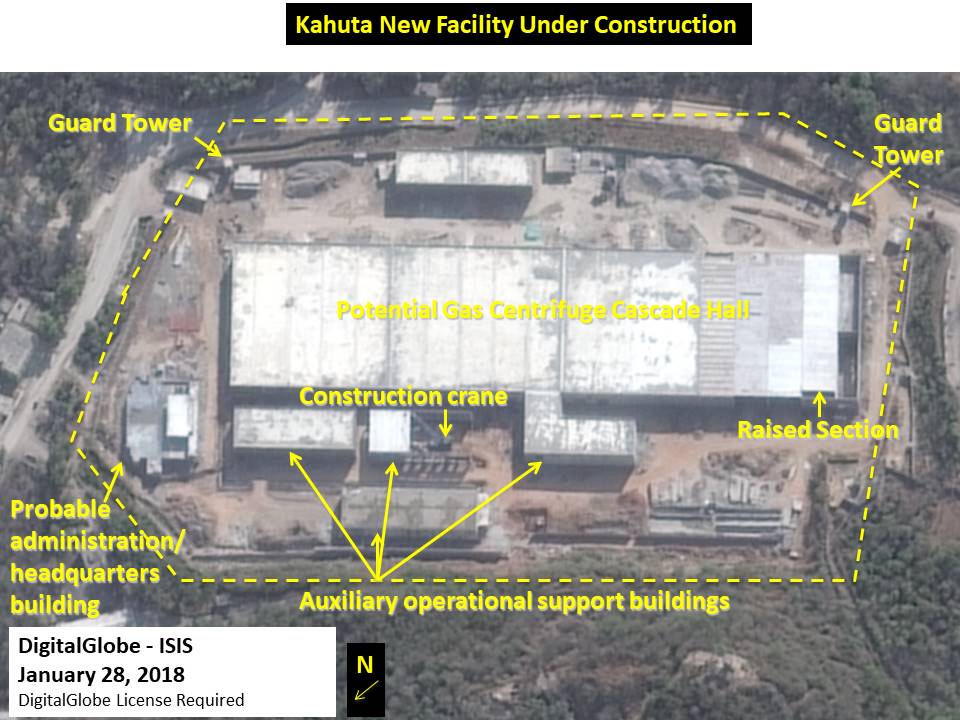

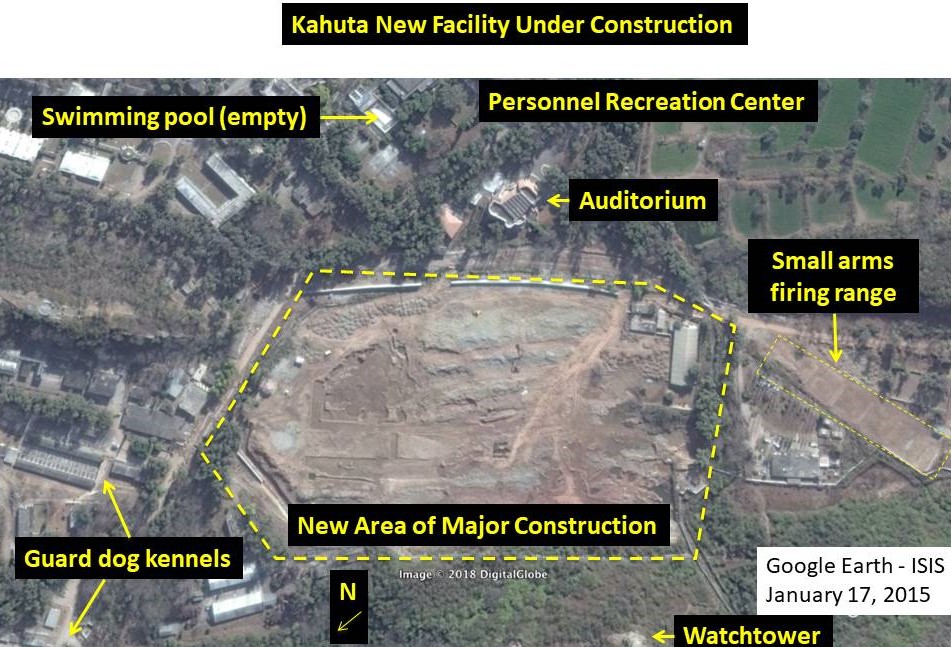

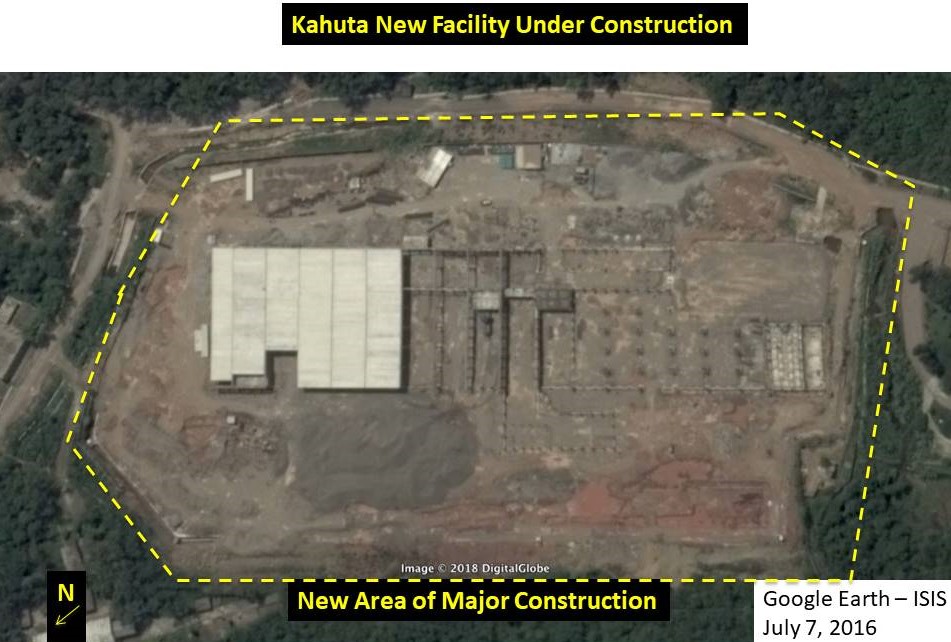
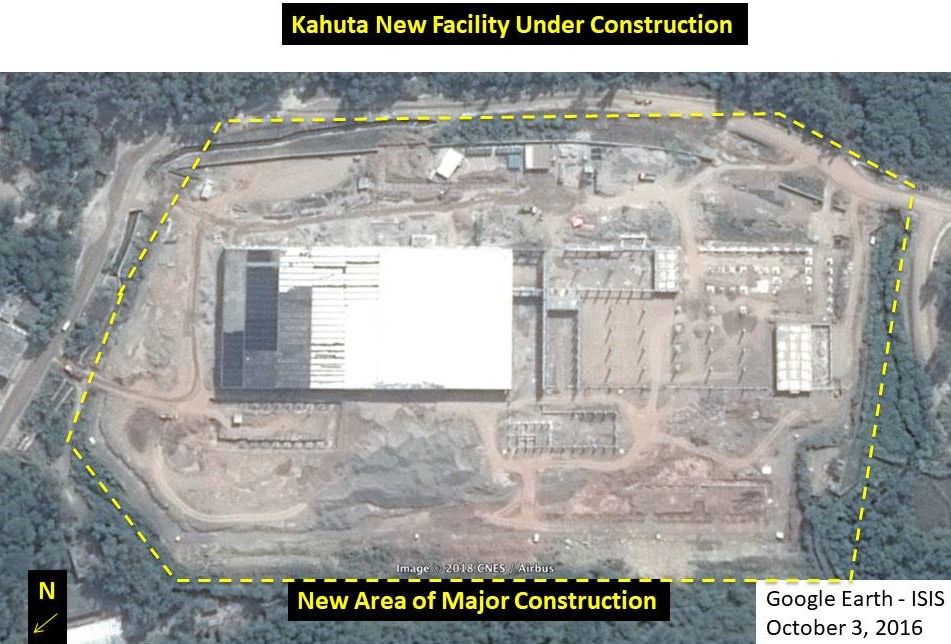
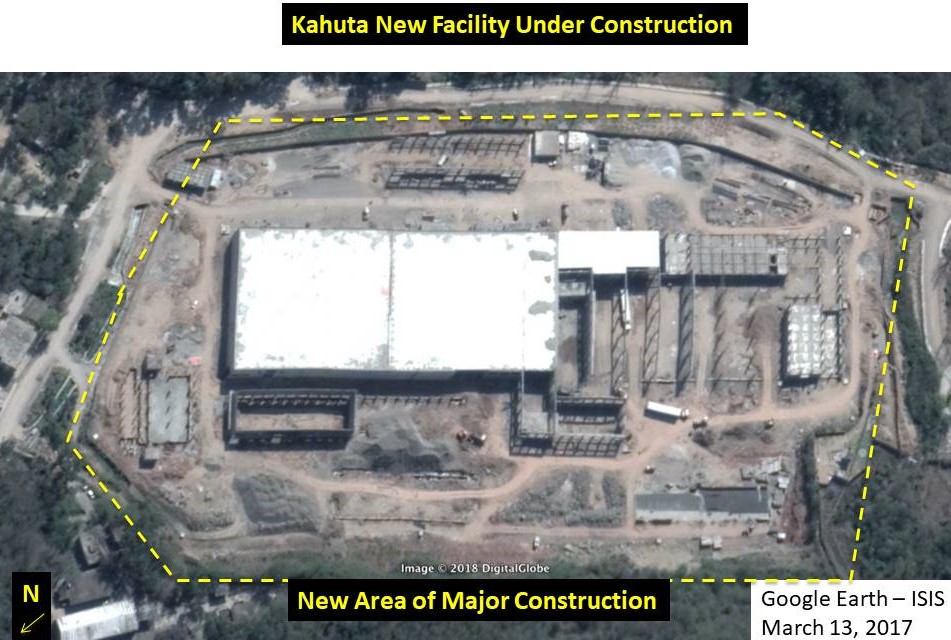
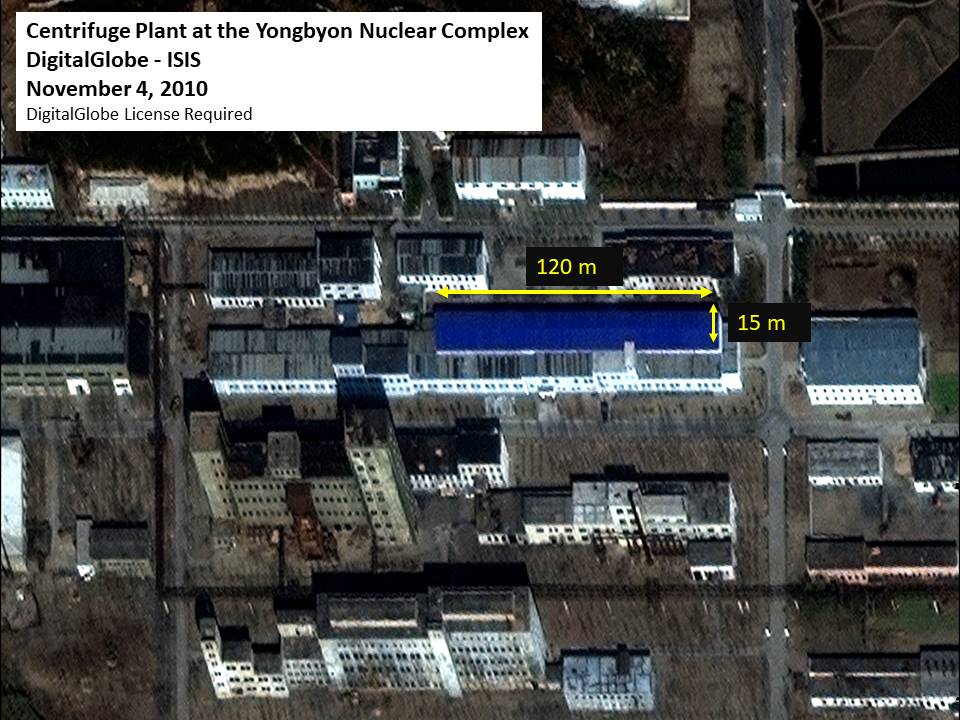

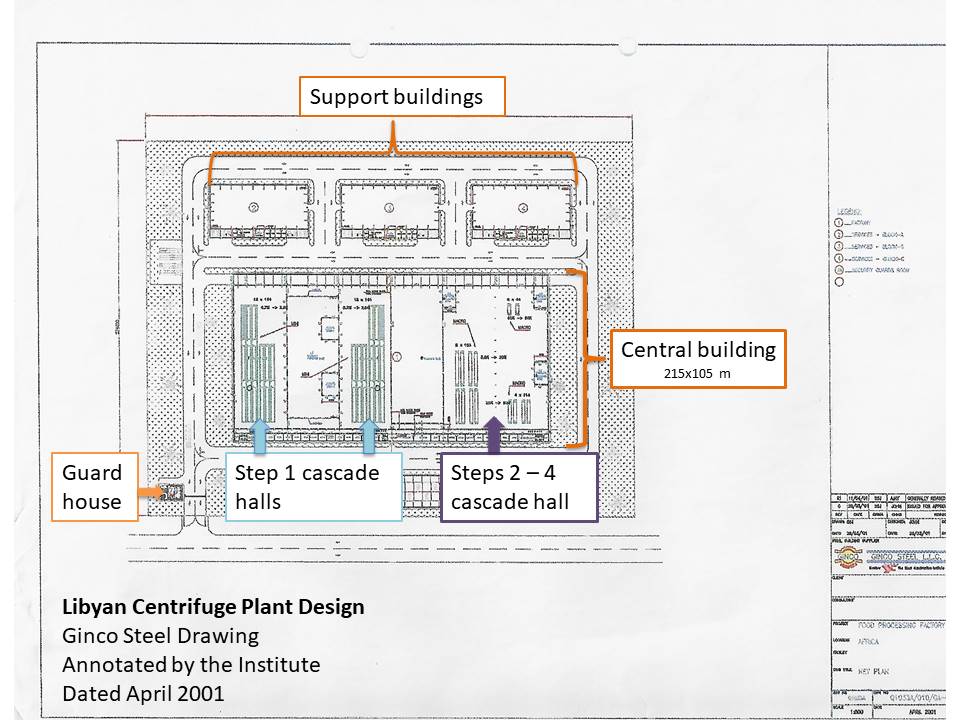
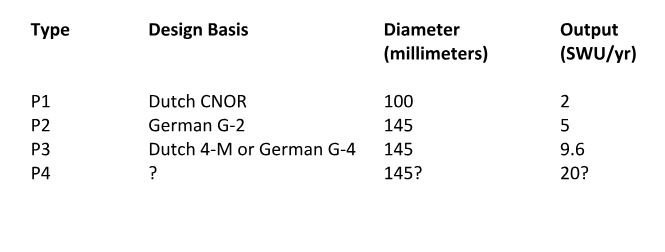
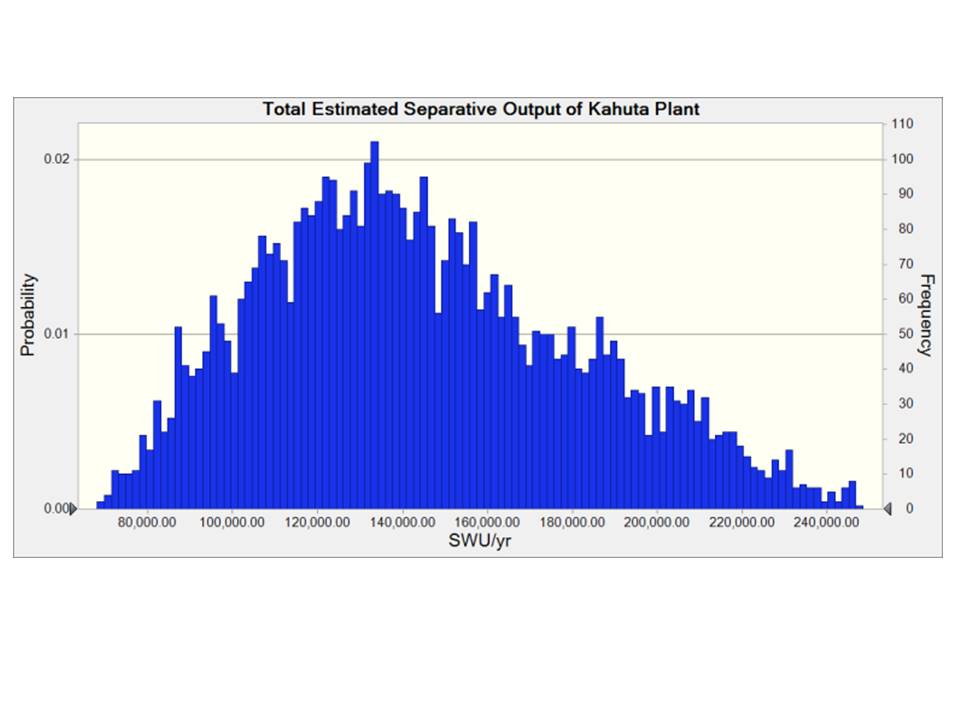
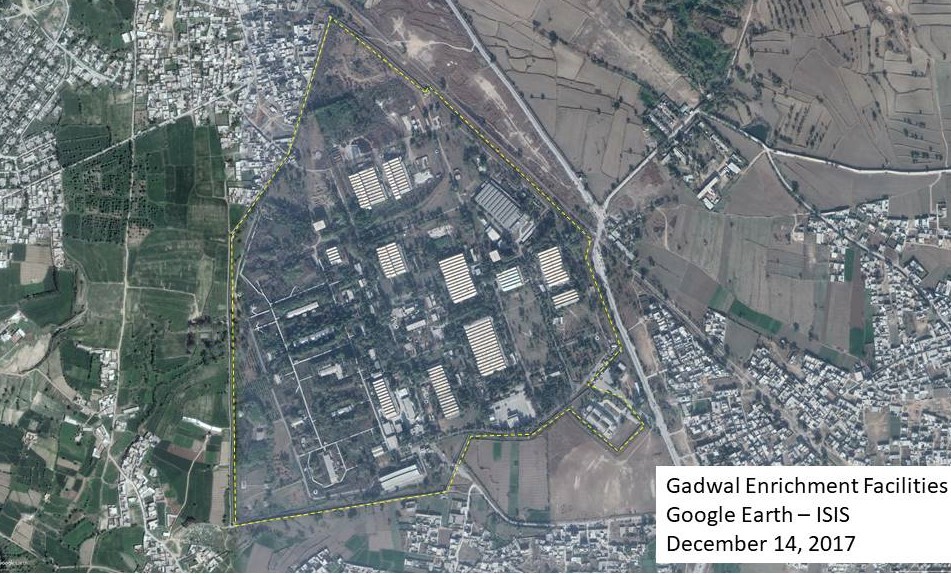
 twitter
twitter